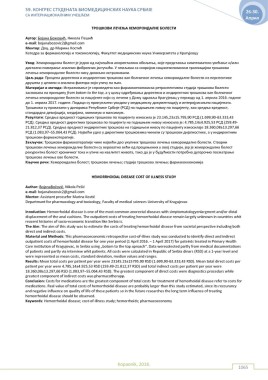Page 1071 - 59. КОНГРЕС СТУДЕНАТА БИОМЕДИЦИНСКИХ НАУКА СРБИЈЕ СА ИНТЕРНАЦИОНАЛНИМ УЧЕШЋЕМ
P. 1071
59. КОНГРЕС СТУДЕНАТА БИОМЕДИЦИНСКИХ НАУКА СРБИЈЕ 26-30.
СА ИНТЕРНАЦИОНАЛНИМ УЧЕШЋЕМ Април
ТРОШКОВИ ЛЕЧЕЊА ХЕМОРОИДАЛНЕ БОЛЕСТИ
Аутор: Бојана Божовић, Никола Пешић
e-mail: bojanabozovic2@gmail.com
Ментор: Доц. др Марина Костић
Катедра за фармакологију и токсикологију, Факултет медицинских наука Универзитета у Крагујевцу
Увод: Хемороидална болест је једно од најчешћих аноректалних обољења, које представља симптоматско увећање и/или
дистално померање аналних фиброзних јастучића. У земљама са скоријом социоекономском транзицијом трошкови
лечења хемороидалне болести нису довољно истраживани.
Циљ рада: Процена директних и индиректних трошкова ван болничког лечења хемороидалне болести из перспективе
друштва у целини и анализа фактора који утичу на њих.
Материјал и методе: Истраживање је спроведено као фармакоекономска ретроспективна студија трошкова болести
заснована на принципу from botom to the top, а у циљу одређивања директних и индиректних трошкова ван болничког
лечења хемороидалне болести за пацијенте који су лечени у Дому здравља Крагујевац у периоду од 1. априла 2016. године
до 1. априла 2017. године. Подаци су прикупљени увидом у медицинску документацију и интервјуисањем пацијената.
Трошкови су приказани у динарима Републике Србије (РСД) на годишњем нивоу по пацијенту, као средња вредност,
стандардна девијација, медијана, минимум и максимум.
Резултати: Средња вредност годишњих трошкова по пацијенту износила је 23.145,23±15.795,90 РСД (1.699,90-63.333,43
РСД). Средња вредност директних трошкова по пацијенту на годишњем нивоу износила је: 4.785,14±4.925,53 РСД (259.49-
21.812,37 РСД). Средња вредност индиректних трошкова на годишњем нивоу по пацијенту износилаје 18.360,08±13.297,66
РСД (1.083,97–55.064,43 РСД). Највећи удео у директним трошковима чинили су трошкови дијагностике, а у индиректним
трошкови фармакотерапије.
Закључак: Tрошкови фармакотерапије чине највећи део укупних трошкова лечења хемороидалне болести. Стварни
трошкови лечења хемороидалне болести су вероватно већи од процењених у овој студији, јер је хемороидална болест
рекурентна болест хроничног тока и утиче на квалитет живота, тако да је у будућности потребно дугорочно посматрање
трошкова лечења ове болести.
Кључне речи: Хемороидална болест; трошкови лечења; студија трошкова лечења; фармакоекономија
HEMORRHOIDAL DISEASE COST OF ILLNESS STUDY
Author: BojanaBožović, Nikola Pešić
e-mail: bojanabozovic2@gmail.com
Mentor: Assistant prossefor Marina Kostić
Departmant for pharmacology and toxicology, Faculty of medical sciences University of Kragujevac
Inroduction: Hemorrhoidal disease is one of the most common anorectal diseases with simptomatologyenlargment and/or distal
displacement of the anal cushions. The outpatient costs of treating hemorrhoidal disease remain largely unknown in countries whit
reacent histories of socio-economic transition like Serbia is.
The Aim: The aim of this study was to estimate the costs of treating hemorrhoidal disease from societal perspective including both
direct and indirect costs.
Material and Methods: This pharmacoeconomic retrospective cost-of-illnes study was conducted to identify direct and indirect
outpatient costs of hemorrhoidal disease for one year period (1 April 2016. – 1 April 2017) for pateints treated in Primary Health
Care institution of Kragujevac, in Serbia using „botom to the top aproach“. Data wеrecolected partly from medical documentations
of patients and partly via interview whit patients. All costs were calculated in Republic of Serbia dinars (RSD) at a 1-year level and
were represented as mean costs, standard deviation, median values and ranges.
Results: Mean total costs per patient per year were 23145.23±15795.90 RSD (1.699,90-63.333,43 RSD). Mean total direct costs per
patient per year were 4.785,14±4.925,53 RSD (259.49-21.812,37 RSD) and total indirect costs per patient per year were
18.360,08±13.297,66 RSD (1.083,97–55.064,43 RSD). The greatest component of direct costs were diagnostics procedurs while
greatest component of indirect costs was pharmacotherapy.
Conclusion: Costs for medications are the greatest component of total costs for treatment of hemorhoidal disease refer to costs for
medications. Real value of total costs of hemorrhoidal disease are probably larger than this study estimated, since its reccurancy
and negative influence on quality of life of these patients so in the future researches the long term influence of treating
hemorrhoidal disease should be observed.
Keywords: Hemorrhoidal disease; cost-of-illness study; hemorrhoids; pharmacoeconomy
Kopaonik, 2018.
1065

